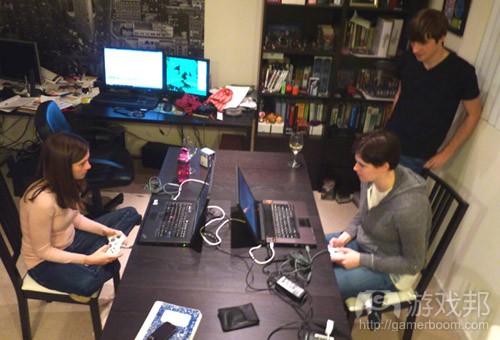开发者谈有益于测试游戏的技巧和工具
作者:Epona Schweer
你是使用何种方法去分析玩家的游戏行为?
Mark Lyons(Floating Man Games):“我们一直在使用Playtomic的分析插件,尽管我们一直在寻找其它更有效的数据获取方法,但是Playtomic的确是一种既简单又有效的工具”
James Murchison(UNSW):“使用UniWeb和UniParse分析并与Unity对接。如果是在准备阶段,你便需要投入更多的精力,因为你必须规划好如何储存数据,但是你所有数据类别将具有多对多的关系,也就意味着你可以从中获得更多信息。所以现在我们为每个玩家重新塑造不同的游戏结构而投入了更多的精力。”
在Unity上进行几个月的测试后我们最终获得了这一方法。除了需要改变你自己的服务器外,这应该是我所见过的最廉价且最有效的解决方法。同时我还想提醒网络开发者注意,它拥有基于rest的API,也就意味着你可以轻松地创建一个属于自己的网站并即时分析各种数据!”
Trevor Dikes(Soundplay Interactive):“我们正在考虑使用Flurry创造我们的下一款游戏。即通过使用Unity,Prime 31(能够快速将iPhone和iPad原生功能整合进自己应用中的插件)创造出一款优秀的Flurry插件并落实行动!”
Ben Britten Smith(Tin Man Games):“我们将在所有手机游戏中使用Flurry以及在所有桌面游戏中使用Playtomic。这两种插件都非常容易进行设置。Flurry虽然较为基础,但是它却能够帮助你有效地记录下任何事件;而Playtomic更是拥有许多像热图等有效的功能。”
Bruce Thomson(Nnooo):“我们使用的是最传统的站立观望法。这种方法在游戏早期开发阶段非常有帮助,并且因为我们开发的是掌机和掌上电脑游戏,所以我们并不能使用桌面和手机工具。同时我们必须牢记的是不能在玩家游戏期间与之交流!我们应该在玩家完成游戏后问他们三个问题:你喜欢什么?你不喜欢什么?哪些内容让你感到困惑?”
Ben Britten Smith(Tin Man Games):“的确,这是三个最经典的问题了!我确实很喜欢我们的热图点击分析,但是事实上,当我们看到玩家在我们认为极具人性化的界面上横冲直撞,因为我们未能明确表达游戏玩法而感到困惑,或者忽视了我们花费了很长时间而编写出来的指示文本时,甚至发现许多我们认为已经解决的漏洞时,我们真的会备受打击。
而站立观望(或者录制视频的模式会更加合适)真的是早期游戏测试和设计过程中对你最有帮助的方法!”
Rebecca Fernandez(Convict Interactive):“我们进行了调查,并规划出了一些合理的问题,但是事实上我们却很难真正落实这些问题。”
Nikhil Suresh(REVISION.9):不要怀有“我的游戏非常优秀,任何人都不可能在此找到任何漏洞,我从来都不需要对此做出修改(至少在我第一次炫耀自己的游戏时我们会这么想)”这种情绪。
Nikhil的最后一点内容更是强调了为何测试在游戏开发过程中如此重要。
你正在进行一个实验,并且需要玩家的参与。你可以创造出所有的音效,图像和代码,但是在玩家能够开始控制游戏前,你都不算真正完成游戏。
如果你越早将玩家带进游戏设计中,你便能够越早结合玩家体验而开发游戏。
你能否想象自己花费了大量时间和精力最终却只开发出一款难以博得玩家欢心的游戏?
好吧,这也不是什么稀奇事了。而对于那些独立开发游戏,并主要依赖于临时的焦点小组测试的工作室来说,他们该如何做才能在游戏发行时获得玩家的积极反馈?
好吧,今天我并不是要讨论如何在游戏未准备充足前将其投入市场中,我是想在此强调玩家互动是少数能够用于区别游戏与其它媒体(游戏邦注:如电影,音乐和故事等)的元素,也是创造出出色游戏设计的重要组成部分。当你在开发游戏时,你不仅是在设计一种游戏体验,你同时也是在设计计玩家的首次个人经历。
例子:我所指导过的一名独立游戏开发者让我帮他测试自己新游戏的首个纸上原型。一开始他企图教我如何游戏,我很郁闷地让他住嘴了——因为我想好好看看他所设计的“界面”是如何引导着我进行游戏。
但是当我前进了第一步时我便困惑了,因为桌面上设有太多的数据,使得我很难看清下一步该怎么走。他马上意识到了这一问题,并想办法引导着我朝他预想的方向而前进——并且让我也未意识到这种引导。
在短短的15分钟内他便创造出另外一个版本的游戏让我再次尝试。
而与此相比,那些宁愿在游戏发行后才对这些问题后知后觉的工作室便很容易在游戏开始的前几分钟便失去大量玩家。(本文为游戏邦/gamerboom.com编译,拒绝任何不保留版权的转载,如需转载请联系:游戏邦)
Playtesting Tips and Tools for Game Designers
Epona Schweer
What are you using to analyse player behavior in game?
Mark Lyons (Floating Man Games): “We have been playing around with Playtomic, still working out the best way to get all the data we want but it is really easy to setup and get working.”
James Murchison (UNSW): “Parse along with UniWeb and UniParse to interface with Unity. It is a little more work on the setup phase, in that you have to design how you’re going to store your data, but all of your data classes can have a many to many relationship, which means you can mine SOOOOOO much information from them. We’re at a point now where with a little more work we can essentially reconstruct every play through from every player.
This method comes after a couple of months of testing various solutions on Unity. Besides rolling your own server, that is the cheapest and best solution I’ve found. Something I will note for web developers, is that it has a rest based API, which means you can easily build your own website to analyze the data in real time!
Trevor Dikes (Soundplay Interactive): “We’re looking at implementing Flurry into our next build. Using Unity, Prime 31 makes an excellent Flurry plugin that makes the implementation a breeze!”
Ben Britten Smith (Tin Man Games) “We use Flurry for all our mobile stuff and Playtomic for the desktop stuff. Both super easy to setup. Flurry is pretty basic but still quite powerful once you wrap your brain around the best ways to record events, and Playtomic has a ton of really useful things like heatmapping etc.”
Bruce Thomson (Nnooo): We use old fashioned standing and watching. It helps us immensely in early development, and as we develop for consoles and handhelds we can’t access all the fancy desktop and mobile tools. It’s important (and hard to resist) to NOT interact with the player while they’re playing! We ask 3 questions at the end: What did you like? What didn’t you like? What confused you?”
Ben Britten Smith (Tin Man Games): ”Ahh yes, the classic three questions! I do love me some super fancy heat-mappy-clicky-county analytics, but yeah, nothing really beats being able to watch people as they fumble around the interface that you thought was so user-friendly, get stuck and confused about what to do next because you haven’t signposted the gameplay well enough, ignore all of the instructional text that you spent so long writing, find all of the crashing bugs you thought had been fixed, etc.
Standing and watching (or even better, getting video) is absolutely the 100% best thing you can do during early playtesting and design. Can’t recommend it enough!”
Rebecca Fernandez (Convict Interactive): “We do surveys. Working out the correct questions, however, and the way in which those questions are worded can be quite difficult.”
Nikhil Suresh (REVISION.9): /sarcasm ON “My game is so good people don’t make any mistakes in it and it’s the best implementation ever and never has to change.” /sarcasm OFF. “At least that’s I thought when I first showed off a game.”
Nikhil’s last point underscores why playtesting is so critical in game development.
You are making an experience that requires the presence of a player. You can have all the sound, art and code done, compiled and ready to go – but until a player sets hands to controls you don’t have a complete game.
The sooner you involve a player in your game design the sooner you can start developing across the whole experience.
Can you imagine how horrible it would be to spend years pouring sweat and time and money into development only to release something that players don’t enjoy?
Oh wait, that happens all the time. And how well does it turn out for those studios who develop in isolation, relying on the occasional focus group test safely quarantined away from production, gambling everything on a positive player response at launch?
Well, there aren’t many of them around anymore.
Now I’m not arguing for releasing your game into the wild before it’s ready, but player interaction is one of the few elements distinguishing a game from other mediums (film/music/story) – and it’s what makes game design so damn COOL! Not only are you designing an experience but you’re designing HOW another person experiences that subject for the first time.
Case in point: One of the indies I coach just called me over to test the first pen and paper prototype of his new game. He started trying to tell me how to play and I shushed him – I wanted to see how well he designed the “interface” to guide me through play.
After the first move I was stumped, there was too much data on the table to see what I could do next to progress play. He saw that and immediately realised what he could do to help guide my eyes to the next action he wanted me to take – without me being AWARE of being guided.
In fifteen minutes he could have another version of the game ready for me to play.
Compare that to a studio waiting until launch to realise that they’re losing players within the first few minutes of gameplay.(source:indiebits)








































 闽公网安备35020302001549号
闽公网安备35020302001549号